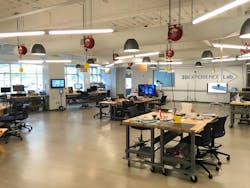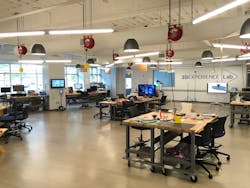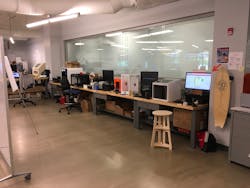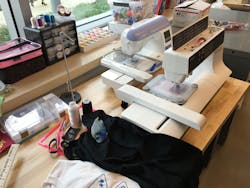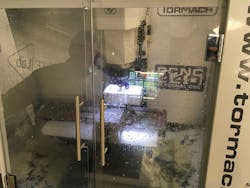A Field Trip to the 3D Experience Fab Lab
Field trips are always fun. Any kid in school can tell you that escaping the classroom is the best kind of school day, short of having a substitute teacher and watching a video. I was recently able to experience a field day trip myself when Dassault Systemes invited me on a tour of its 3D Experience Fab Lab.
The 3D Experience Fab Lab opened its doors in Boston on May 30, 2017, for anyone looking to become a creator (aka a fabber).
A fab lab is a “fabrication lab” designed to offer communities a place to tinker, design, and create. It’s basically a small-scale workshop that houses a variety of modern design tools including computers, 3D printers, laser cutters, 3-axis CNC machines, water jet cutters, and digital electronics like microprocessors, Arduino boards, and circuit stations. The original fab lab program was a collaboration between the Grassroots Invention Group and the Center for Bits and Atoms at the Media Lab at Massachusetts Institute of Technology (MIT) back in 2001.
The lab is host to an array of different machinery including 3D printers, laser cutters, and modeling software.
There are two 3D Experience Labs, one in Paris and the new Boston lab, which had its grand opening May 30. It has a design engineer capacity of 55 and hosts several tools and workstations for any design project imaginable. Along with hosting the basic design machines like a 3D printer and CNC machine, it also has a sewing machine, tablet workstation with drawing pens, a 3D object scanner for modeling, and a telepresence robot for communications with other design sites. The lab is a 3,100-square-foot setup in collaboration with MIT’s Center for Bits and Atoms. The lab is connected to over 1,000 other maker spaces through the Fab Foundation network.
The main attraction is the Mentor-Fabber Collaboration Model, which brings young students and engineering mentors together in the fab lab. A fabber (user) invests a total of 20 hours in mentor-assisted training across all the lab tools and gains full access to all the tools and facilities of the lab. The fab lab has three different collaboration levels:
Bring Your Own Projects (BYOP): Fabbers and mentors from the Dassault Systemes community can work on their own personal projects, be it a special-purpose drone or a lightweight laptop accessory.
Fab Lab Startup Kit: These are ready-to-go individual or collaborative projects, indexed from simple to complex, that new fabbers can immediately start working on with their mentors.
Work on an in-house project: Fab Lab has a number of longer-term projects that a fabber or mentor can be part of and enhance his or her skills in the process, ranging from collaborative projects with MIT or other partners, proof-of-concept prototypes with local startups, or exchange projects with other fab labs from across the world.
Boot Camps and Hackathons: Project- and activity-based collaborations with external agencies such as STEM organizations, local schools, and universities across themes of education, engineering, and entrepreneurship. They can use the facility to host events that encourage collaboration, creativity, and aim to push the envelope of maker movement.
The tools in the 3D Experience Fab Lab range from the classic sewing machinet (top) and the traditional CNC machine (above).
According to Dassault Systemes, “The Fab Lab theme is devoted to understanding and supporting the Maker/Fab/Hacker movement. Our goal is to create the physical and digital spaces to explore this social movement, and to enable ourselves and others to innovate through design and manufacturing. Together, we believe we can move closer to an economy that is at once successful, meaningful, and sustainable.”
